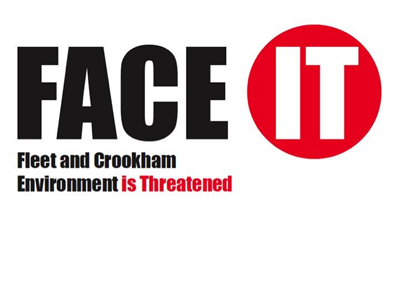This resource will be updated regularly, so if there are any other definitions that you think would be useful here, please let us know.
Ancient woodland
Ancient woodland, usually defined as land that has been continually wooded since at least 1600AD, is the jewel in our woodland crown. They are our richest sites for wildlife and support a huge range of wildlife (including more threatened species than any other UK habitat). Ancient woods are also some of our prettiest woodlands, some have carpets of bluebells, wood anemones and celandines in spring.
Sadly, nearly 50 per cent of the ancient woodland that survived until the 1930s has since been lost or damaged by agriculture or development. Most of ancient woodland we have left is fragmented and nearly 50 per cent of ancient woods are less than 5 hectares (13 acres). Netherhouse Copse and Jack Reid’s Copse off Hitches Lane west of Fleet are both Ancient Woodlands and SINCs.
Biodiversity
This is a term commonly used to describe the variety of life on Earth, encompassing the whole of the natural world and all living things with which we share the planet. It includes plants, animals, even invisible micro-organisms and bacteria which, together, interact in complex ways with the inanimate environment to create living ecosystems.
Biodiversity Net Gain (BNG)
BNG is a requirement deriving from the Environment Act (2021) and came into force for developers in England from 2024. Developers must deliver a net gain in biodiversity which means a development will result in more or better quality natural habitat than there was before development. BNG can be provided on-site or bought from elsewhere across Hart District and beyond. In contrast to SANG, it doesn’t necessarily involve public access.
Conservation Area
An area of special architectural or historic interest the character or appearance of which it is desirable to preserve or enhance. Historic areas of distinctive quality and character have a strong sense of place and provide continuity and stability in a rapidly changing world. Much of Crookham Village and the Basingstoke Canal are Conservation Areas and require that special permission be given before making any changes to boundaries, buildings or trees.
Five Year Land Supply
The requirement for a Local Planning Authority (in our case, Hart) to have enough land available to deliver the designated supply of housing for the next five years. This is required throughout the period of the Local Plan (and at the end, therefore, extends beyond the plan period).
Green and Pleasant Land
Apparently they have stopped making this, so we will not get any more…
Housing Trajectory
The plan for the number of new dwellings to be built each year of the period covered by the Local Plan.
LDF: Local Development Framework
now known as the Local Plan
The Local Plan is a collection of documents produced by the local planning authority (here Hart District Council) which collectively form the spatial planning strategy for its area. The core strategy within the Local Plan sets out the vision, strategic objectives and delivery strategy for achieving these. In English, this is the plan that defines where and how many houses are to be built. Until now, this has been a draft.
NPPF: National Planning Policy Framework
This is the UK government planning guidance document published in March 2012. It simplifies red tape in planning procedures, especially for developers. There are a number of hot topics in the document that are still being assessed, like the real definition of Sustainable Development. The clear interpretation of the NPPF is important and will have a great affect on future development across the UK. It will define our legacy. The NPPF requires that Hart have an LDF in place by 27 March 2013.
SANG: Suitable Alternative Natural Greenspace
SANGs are areas of exisiting open space that have been identified for enhancement so that they can be made more accessible and attractive to visitors. The hope is that by providing alternative areas for the general public to use for outdoor recreation (including dog walking), it will help lessen the impact on the Thames Basin Heaths SPA as new households can use the SANG instead of the protected heathland.
SINC: Site of Interest to Nature Conservation
Hampshire has a wealth of wildlife habitats including heathland, ancient woodland, chalk rivers, old meadows and wetlands. A site may also qualify if it supports a rich assemblage of species. To help safeguard these sites for the future, they are being identified and recorded as SINCs. These are generally administered by local authorities in partnership with conservation organisations. All sites are assessed against detailed criteria developed by Hampshire County Council, Natural England and the Hampshire & Isle of Wight Wildlife Trust. In Hampshire this system supports over 3,700 sites (9% of Hampshire’s land area) which contributes significantly to delivering both UK and Hampshire Biodiveristy Action Plan targets.
SPA: Special Protection Area
SPAs are areas which have been identified as being of international importance for the breeding, feeding, wintering or the migration of rare and vulnerable species of birds found within European Union countries. They are European designated sites, classified under the ‘Birds Directive 1979’ which provides enhanced protection given by the Site of Special Scientific Interest (SSSI) status all SPAs also hold. Hart’s Thames Basin Heath SPA is home to three rare species of ground nesting birds – the Dartford Warbler, Nightjar and Woodlark.
SSSI: Site of Special Scientific Interest
SSSIs are the country’s very best wildlife and geological sites. They include some of the most spectacular and beautiful habitats; wetlands teeming with wading birds, winding chalk rivers, flower-rich meadows, windswept shingle beaches and remote upland peat bogs. There are over 4,100 Sites of Special Scientific Interest (SSSIs) in England, covering around 8% of the country’s land area. More than 70% of these sites (by area) are internationally important for their wildlife.
